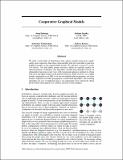Cooperative graphical models
Author(s)
Jegelka, Stefanie Sabrina
DownloadPublished version (1.506Mb)
Publisher Policy
Publisher Policy
Article is made available in accordance with the publisher's policy and may be subject to US copyright law. Please refer to the publisher's site for terms of use.
Terms of use
Metadata
Show full item recordAbstract
We study a rich family of distributions that capture variable interactions significantly more expressive than those representable with low-treewidth or pairwise graphical models, or log-supermodular models. We call these cooperative graphical models. Yet, this family retains structure, which we carefully exploit for efficient inference techniques. Our algorithms combine the polyhedral structure of submodular functions in new ways with variational inference methods to obtain both lower and upper bounds on the partition function. While our fully convex upper bound is minimized as an SDP or via tree-reweighted belief propagation, our lower bound is tightened via belief propagation or mean-field algorithms. The resulting algorithms are easy to implement and, as our experiments show, effectively obtain good bounds and marginals for synthetic and real-world examples.
Date issued
2016-12Department
Massachusetts Institute of Technology. Department of Electrical Engineering and Computer ScienceJournal
Advances in Neural Information Processing Systems
Publisher
Morgan Kaufmann Publishers
Citation
Djolonga, Josip et al. “Cooperative graphical models.” Advances in Neural Information Processing Systems, 29 ( December 2016 © 2016 The Author(s)
Version: Final published version
ISSN
1049-5258